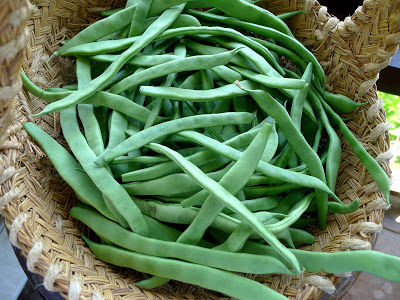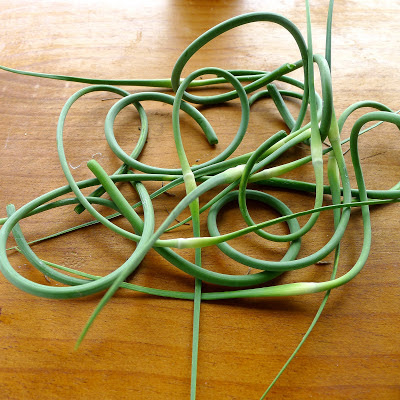 |
| Just picked--a basket of beans. |
I wrote about green beans on one of my first ever blog posts
(recipe here). Then, I was picking the last of the late-summer crop. Now I’m picking the first of the spring planting.
Welcome back, beans!
 |
| Beans climb up caña poles. |
I’m wild about beans. I cook up a mess of beans and store them, refrigerated, ready to add to different dishes. I heap beans onto mixed salad with tuna or sliced chicken for a satisfying lunch. I serve them, reheated, as a vegetable side, with only a drizzle of extra virgin olive oil. Beans go into potato salad with tangy lemon dressing (or, as in Ferran Adrià’s book,
The Family Meal, with Chantilly-mayonnaise foam). I add green beans to stir-fries and to curries. I like beans with a sprinkling of toasted almonds, with bacon bits or with walnut pesto sauce.
In Spain, rarely do you find green beans served as a “plain” side dish alongside a meat or chicken main. Beans (known as
judías verdes,
habichuelas or
alubias), as with other vegetables, are more likely to turn up as a starter, in place of a salad or soup, or as an ingredient in the salad or soup. Or, in paella. Flat green beans go into authentic Valencian paella.
Nor is “crisp-tender” part of the lexicon of Spanish home cooking. Beans are more likely to be cooked until quite limp. Slow-cooking is a fine technique for mature beans that can be quite fibrous.
Timing? It sort of depends on the beans—small and freshly picked or leggy and mature—and the quantity. For crisp-tender, I cook a pound of beans, topped and tailed, in two quarts of boiling salted water for 4 to 5 minutes (timed from when water returns to a boil). After draining, I plunge beans in ice water to stop the cooking.
Both of the following recipes include vinegar—a tangy complement to beans. Add the vinegar dressing or sauce to the beans shortly before serving, as vinegar tends to turn the beans from a lively green to a dull color.
 |
| A jumbled salad of beans, potatoes, greens and peppers. |
Green Bean Salad
Ensalada de Judías VerdesYou might add slivered salchichón (similar to salami) or minced anchovies to this salad. Flame-roasted bell pepper is best for this recipe, but, if not available, used canned pimiento.
Serves 6.
1 ½ pounds green beans
2 medium potatoes
2 cloves garlic, minced
1 green onion, chopped
½ roasted red bell pepper, diced
¼ teaspoon crumbled dry oregano
Red pepper flakes, to taste
¼ cup extra virgin olive oil
¼ cup vinegar
Salt and pepper
Lettuce leaves
2 hard-boiled eggs, sliced
Black olivesTop and tail the beans, but leave them whole. Cook in boiling, salted water to desired degree of doneness (crisp-tender or well done). Drain and refresh under cold water.
Cook the potatoes in boiling water until tender. Drain. Peel and cut the potatoes in lengthwise wedges.
Combine the beans and potatoes in a bowl. Add the garlic, onion, diced pepper, oregano, red pepper flakes, oil, vinegar and salt and pepper. Combine gently. If desired, let the ingredients marinate at room temperature for 1 hour. The beans will lose their bright green color but absorb more of the flavoring of the dressing.
Place lettuce leaves on a serving platter. Arrange the beans and potatoes on top of the lettuce. Spoon over all the remaining dressing. Garnish with sliced eggs and a few olives.
 |
| Beans and peppers with a garlicky sauce--a great vegetarian main dish. |
Green Beans in Garlicky Sauce
Judías Verdes en SalsaTurn this into a vegetarian main dish by adding eggs—hard-boiled or poached—to the beans. Use a vegetable peeler to remove some of the skin from the red bell pepper before cutting into slivers.
Serves 4.
 |
| Peel the pepper's skin. |
1 pound green beans, preferably the flat variety
1 slice white bread, crusts removed
2 tablespoons wine vinegar
1 clove garlic
½ teaspoon sweet pimentón (paprika)
Hot pimentón or cayenne, to taste
3 tablespoons olive oil
½ cup slivered red bell pepper
Salt and pepper to taste
Hard-cooked or poached eggs (optional)Cut the beans into 2-inch lengths. Cook in boiling salted water until crisp-tender (about 4 minutes). Drain, saving ½ cup of the liquid. Refresh the beans in cold water.
Sprinkle the bread with the vinegar and let it stand until softened. Place the bread, garlic, pimentón and ¼ cup of reserved bean liquid in a blender and blend until smooth.
Heat the oil in a skillet and sauté the beans with the slivered red pepper for 5 minutes. Add the garlic paste and the remaining ¼ cup of bean liquid. Cook 3 minutes more.
Serve with eggs, if desired. Serve hot or room temperature.
Here's my lunch after I took the photos--I dumped the bean and potato salad with peppers and strips of salchichón into a bowl. Delicious. I could eat beans at every meal. And, for a few weeks, I probably will!
























